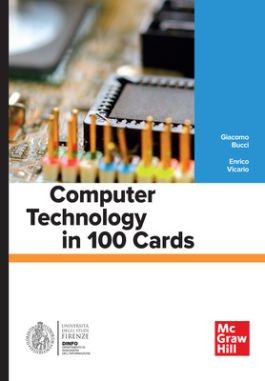COMPUTER TECHNOLOGY IN 100 CARDS
1ed
8838623279
·
9788838623271
© 2025 | Data di Pubblicazione: 20 Luglio 2025
This book is a description of the objects that are part of a small museum being set up at the Department of Information, School of Engineering, University of Florence. It also includes several pages dedicated to the most notable computers of the past…
Continua a leggere
THE FIRST STEPS (Cards 1-7)
MAINFRAMES (Cards 8- 0)
SUPERCOMPUTERS (Cards 11-13)
MINICOMPUTERS (Cards 14-17)
MICROPROCESSORS (Cards 18-43)
MEMORY (Cards 44-54)
STORAGE MEDIA (Cards 55-69)
MECHANICAL and ELECTROMECHANICAL CALCULATORS (Cards 70-73)
SYSTEMS or PART OF SYSTEMS (Cards 74-84)
PORTABLE COMPUTERS Cards (85- 96)
PALM COMPUTERS (Cards 97-98)
HEAT SINKS and OTHER OBJECTS (Cards 99-100)
MAINFRAMES (Cards 8- 0)
SUPERCOMPUTERS (Cards 11-13)
MINICOMPUTERS (Cards 14-17)
MICROPROCESSORS (Cards 18-43)
MEMORY (Cards 44-54)
STORAGE MEDIA (Cards 55-69)
MECHANICAL and ELECTROMECHANICAL CALCULATORS (Cards 70-73)
SYSTEMS or PART OF SYSTEMS (Cards 74-84)
PORTABLE COMPUTERS Cards (85- 96)
PALM COMPUTERS (Cards 97-98)
HEAT SINKS and OTHER OBJECTS (Cards 99-100)
This book is a description of the objects that are part of a small museum being set up at the Department of Information, School of Engineering, University of Florence. It also includes several pages dedicated to the most notable computers of the past, though they are not part of the small museum. The title of the book suggests that there is a single sheet for each object. Unfortunately, this has not always been possible, so some pages contain more than one item, while some contain the opposite. In any case, each card has a number; for example, the card dedicated to the ”AMD64 architecture” is number 38, therefore in the Contents it appears as ``38. AMD64 architecture''. To make cross-referencing easier, the card number of a given item is added (within parentheses) in the Index; for instance, near the "AMD64 architecture" is (38). A consistent part of the text is devoted to microprocessors, but also memories, storage media, systems or part of systems, and portable computers have a relevant space. Finally, the first pages are dedicated to the precursors, i.e., to the people who initiated the adventure of digital computers.
Giacomo Bucci is a professor emeritus at the University of Florence. For thirty years, he taught the course Architecture and organization of electronic computers in the Faculty of Engineering. He was a visiting researcher at the IBM Watson Research Center in Yorktown Heights, director of the Department of Systems and Computer Science, and founder of the Software Technologies Laboratory.
Enrico Vicario is a professor of Computer Science and Engineering, actively engaged in scientific research and technological experimentation, with a focus on the quantitative evaluation of stochastic models and software architecture and methodologies. He is the head of the Software Technologies Lab at the Department of Information Engineering of the University of Florence. He had been the director of the Department of Information Engineering.
Giacomo Bucci is a professor emeritus at the University of Florence. For thirty years, he taught the course Architecture and organization of electronic computers in the Faculty of Engineering. He was a visiting researcher at the IBM Watson Research Center in Yorktown Heights, director of the Department of Systems and Computer Science, and founder of the Software Technologies Laboratory.
Enrico Vicario is a professor of Computer Science and Engineering, actively engaged in scientific research and technological experimentation, with a focus on the quantitative evaluation of stochastic models and software architecture and methodologies. He is the head of the Software Technologies Lab at the Department of Information Engineering of the University of Florence. He had been the director of the Department of Information Engineering.

